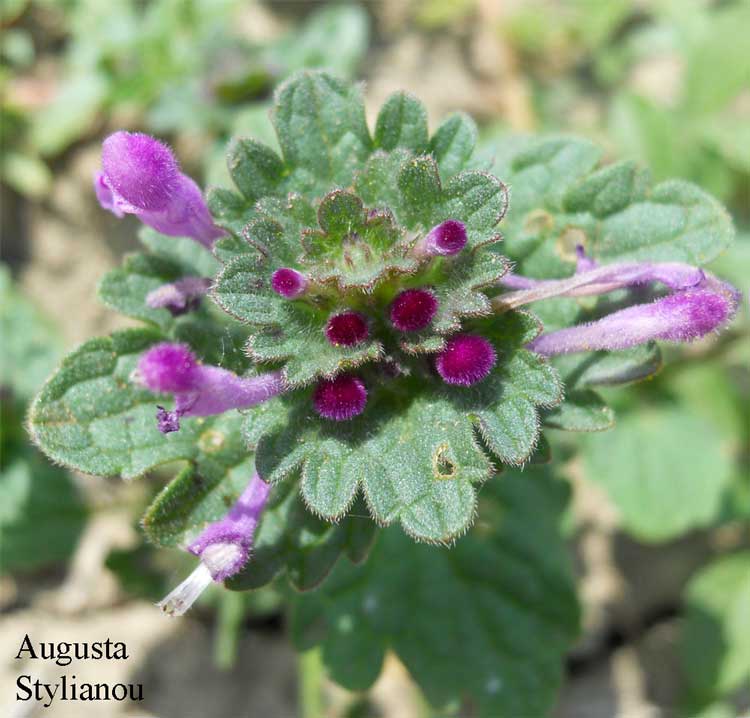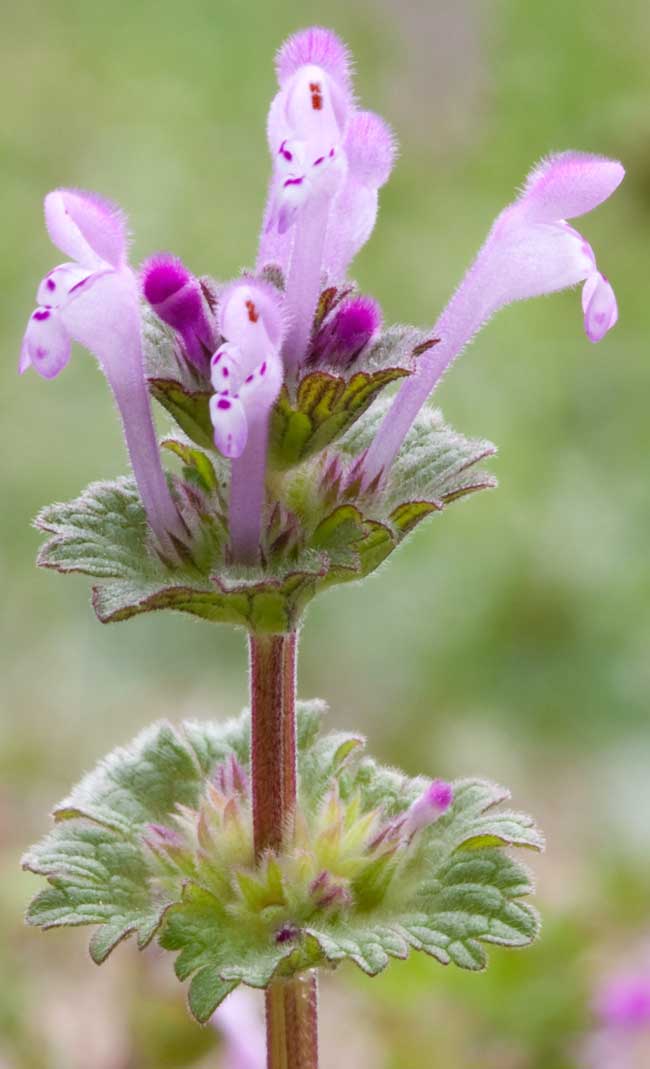
Lamium amplexicaule, Photo: Augusta Stylianou Artist
Classification System: APG IV
Superregnum: Eukaryota
Regnum: Plantae
Cladus: Angiosperms
Cladus: Eudicots
Cladus: Core eudicots
Cladus: Asterids
Cladus: Lamiids
Ordo: Lamiales
Familia: Lamiaceae
Subfamilia: Lamioideae
Tribus: Lamieae
Genus: Lamium
Subgenus: L. subg. Lamium
Sectio: L. sect. Amplexicaule
Species: Lamium amplexicaule
Varietates: L. a. var. aleppicum – L. a. var. amplexicaule – L. a. var. bornmuelleri – L. a. var. incisum – L. a. var. orientale
Name
Lamium amplexicaule L., Sp. Pl.: 579 (1753).
Synonyms
Homotypic
Pollichia amplexicaulis (L.) Willd., Fl. Berol. Prodr.: 198 (1787).
Galeobdolon amplexicaule (L.) Moench, Methodus: 394 (1794).
Lamiopsis amplexicaulis (L.) Opiz, Seznam: 56 (1852).
Lamiella amplexicaulis (L.) E.Fourn., Ann. Soc. Linn. Lyon, n.s., 17: 134 (1869).
Distribution
Native distribution areas:
Continental: Eurasia & Africa
Afghanistan, Albania, Algeria, Austria, Azores, Baleares, Baltic States, Belarus, Belgium, Bulgaria, Canary Is., Central European Rus, China North-Central, China South-Central, China Southeast, Corse, Cyprus, Czechoslovakia, Denmark, East Aegean Is., East European Russia, East Himalaya, Egypt, Ethiopia, Finland, France, Germany, Greece, Hungary, Iran, Iraq, Irkutsk, Italy, Japan, Kazakhstan, Kirgizstan, Korea, Krasnoyarsk, Kriti, Krym, Lebanon-Syria, Libya, Madeira, Morocco, Nansei-shoto, Nepal, Netherlands, North Caucasus, North European Russi, Northwest European R, Norway, Ogasawara-shoto, Oman, Pakistan, Palestine, Poland, Portugal, Qinghai, Romania, Sardegna, Saudi Arabia, Sicilia, Sinai, South European Russi, Spain, Sweden, Switzerland, Tadzhikistan, Tibet, Transcaucasus, Tunisia, Turkey, Turkey-in-Europe, Turkmenistan, Ukraine, Uzbekistan, West Himalaya, West Siberia, Xinjiang, Yakutskiya, Yugoslavia
Introduced into:
Alabama, Alaska, Alberta, Argentina Northeast, Argentina Northwest, Argentina South, Arizona, Arkansas, Bermuda, Bolivia, British Columbia, California, Chile Central, Chile North, Colombia, Colorado, Connecticut, Delaware, District of Columbia, Ecuador, Falkland Is., Florida, Free State, Georgia, Great Britain, Greenland, Hawaii, Iceland, Idaho, Illinois, Indiana, Iowa, Ireland, Kansas, Kentucky, Kuril Is., Labrador, Louisiana, Magadan, Maine, Manitoba, Maryland, Massachusetts, Mexico Southeast, Michigan, Minnesota, Mississippi, Missouri, Montana, Nebraska, Nevada, New Brunswick, New Hampshire, New Jersey, New Mexico, New York, New Zealand North, New Zealand South, Newfoundland, Norfolk Is., North Carolina, North Dakota, Northwest Territorie, Nova Scotia, Ohio, Oklahoma, Ontario, Oregon, Pennsylvania, Peru, Primorye, Prince Edward I., Québec, Rhode I., Sakhalin, Saskatchewan, South Carolina, South Dakota, St.Helena, Tennessee, Texas, Utah, Vermont, Virginia, Washington, West Virginia, Wisconsin, Wyoming, Yukon
References: Brummitt, R.K. 2001. TDWG – World Geographical Scheme for Recording Plant Distributions, 2nd Edition

Lamium amplexicaule
References
Primary references
Linnaeus, C. 1753. Species Plantarum. Tomus II: 579. Reference page.
Additional references
Mennema, J. 1989. A taxonomic revision of Lamium (Lamiaceae). Leiden Botanical Series 11: 1–196. PDF Reference page.
Wu Zhengyi, Raven, P.H. & Hong Deyuan (eds.) 1994–2013. Flora of China. 25 vols. Science Press, Beijing & Missouri Botanical Garden Press, St. Louis. Online at eFloras.org Reference page.
Links
Govaerts, R. et al. 2022. Lamium amplexicaule in World Checklist of Selected Plant Families. The Board of Trustees of the Royal Botanic Gardens, Kew. Published online. Accessed: 2022 Mar 25. Reference page.
Hassler, M. 2022. Lamium amplexicaule. World Plants: Synonymic Checklists of the Vascular Plants of the World In: Roskovh, Y., Abucay, L., Orrell, T., Nicolson, D., Bailly, N., Kirk, P., Bourgoin, T., DeWalt, R.E., Decock, W., De Wever, A., Nieukerken, E. van, Zarucchi, J. & Penev, L., eds. 2022. Species 2000 & ITIS Catalogue of Life. Published online. Accessed: 2022 Mar 25. Reference page.
Tropicos.org 2022. Lamium amplexicaule. Missouri Botanical Garden. Published online. Accessed: 25 Mar 2022.
International Plant Names Index. 2022. Lamium amplexicaule. Published online. Accessed: Mar 25 2022.
Vernacular names
العربية: لاميون ملتف الساق
català: Flor-robí, Galleret, Mataporc, Ninois, Peu de gall, Peu de nostre senyor, Tinya negra
čeština: hluchavka objímavá
Cymraeg: Marddanhadlen goch ddeilgron
dansk: Liden Tvetand
Deutsch: Stengelumfassende Taubnessel, Stängelumfassende Taubnessel
English: henbit deadnettle, greater henbit, common henbit, giraffehead, henbit
español: zapatitos, conejitos, ortiga mansa, alagüeña, chupón, chupones, conejito, flor rubí, gallitos, gargantilla, lamio, manto de la Virgen, minutisa, ortiga muerta, ortiga muerta menor, tirarrina, zapaticos del Señor, zapatitos de la Virgen
فارسی: لامیوم امپلکسیکال
suomi: Sepiväpeippi
français: Lamier amplexicaule, Lamier à feuilles embrassantes
Gàidhlig: Caoch-dheanntag Chearc
עברית: נזמית לופתת
hornjoserbsce: Mała cycawka
日本語: ホトケノザ, 三階草, ほとけのざ, サンガイグサ
한국어: 광대나물
Nederlands: Hoenderbeet
occitan: Mauvige
polski: Jasnota różowa
português: chupapitos, lâmio, lâmio-violeta, urtiga-branca
slovenčina: hluchavka objímavá
svenska: Mjukplister
Türkçe: Büyük ballıbaba
українська: Глуха кропива стеблеобгортна
中文: 宝盖草
Lamium amplexicaule, commonly known as common henbit, or greater henbit, is a species of Lamium native to Europe, Asia and northern Africa.
It is a low-growing annual plant growing to 10–25 cm (3.9–9.8 in) tall, with soft, finely hairy stems. The leaves are opposite, rounded, 2–3 cm (0.79–1.18 in) diameter, with a lobed margin. The flowers are pink to purple, 1.5–2 cm (0.59–0.79 in) long. The specific name refers to the amplexicaul leaves (leaves grasping the stem).
Description
Henbit is an annual herb with a sprawling habit and short, erect, squarish, lightly hairy stems. It grows to a height of about 40 cm (16 in).[1] The leaves are in opposite pairs, often with long internodes. The lower leaves are stalked and the upper ones stalkless, often fused, and clasping the stems. The blades are hairy and kidney-shaped, with rounded teeth. The flowers are relatively large and form a few-flowered terminal spike with axillary whorls. The calyx is regular with five lobes and closes up after flowering. The corolla is purplish-red, fused into a tube 15 to 20 mm (1⁄2 to 3⁄4 in) long. The upper lip is convex, 3 to 5 mm (1⁄8 to 3⁄16 in) long and the lower lip has three lobes, two small side ones and a larger central one 1.5 to 2.5 mm (1⁄16 to 1⁄8 in) long. There are four stamens, two long and two short. The gynoecium has two fused carpels and the fruit is a four-chambered schizocarp.[2]
This plant flowers very early in the spring even in northern areas, and for most of the winter and the early spring in warmer locations such as the Mediterranean region. At times of year when there are not many pollinating insects, the flowers self-pollinate.
Distribution and habitat
Lamium amplexicaule growing in a garden in Eastern Oklahoma
Henbit dead-nettle is probably native to the Mediterranean region but has since spread around the world. It is found growing in open areas, gardens, fields and meadows.[2]
It propagates freely by seed, where it becomes a key part of a meadow ecosystem, Sometimes entire fields will be reddish-purple with its flowers before spring ploughing. Where common, it is an important nectar and pollen plant for bees, especially honeybees, where it helps start the spring build up.
It is widely naturalised in eastern North America and elsewhere. However, its attractive appearance, edibility, and readiness to grow in many climates often mean it is permitted to grow when other weeds are not. This plant, though common, is not regarded as a threat to local ecosystems. It plays an arguably beneficial role in its environment by providing nectar to pollinators and providing forage for animals. The seed is also eaten by many species of birds.[3]
Uses
The young leaves and shoots can be eaten raw or cooked,[1] as can the stems and flowers. Henbit has a slightly sweet and peppery flavor, similar to celery.
References
Elias, Thomas S.; Dykeman, Peter A. (2009) [1982]. Edible Wild Plants: A North American Field Guide to Over 200 Natural Foods. New York: Sterling. p. 116. ISBN 978-1-4027-6715-9. OCLC 244766414.
"Henbit dead-nettle: Lamium amplexicaule". NatureGate. Retrieved 2013-12-15.
"A Little Bit of Henbit". Southern meadows. 2015-02-06.
Retrieved from "http://en.wikipedia.org/"
All text is available under the terms of the GNU Free Documentation License

